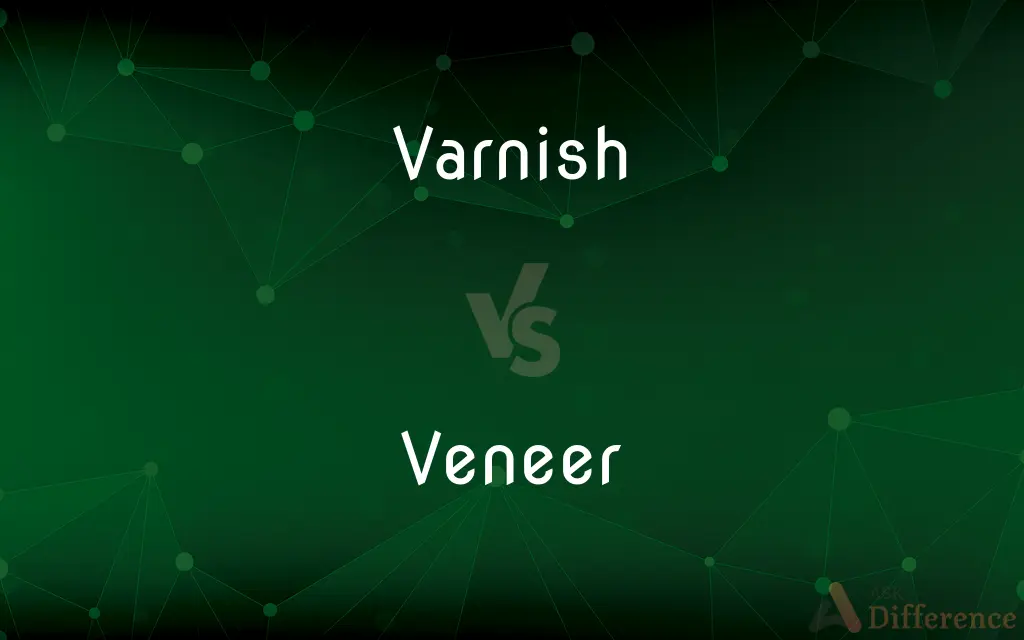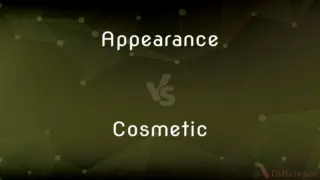Varnish vs. Veneer — What's the Difference?
Edited by Tayyaba Rehman — By Fiza Rafique — Updated on April 25, 2024
Varnish enhances surface protection and glossiness, primarily used as a clear, protective finish, whereas veneer refers to thin layers of superior wood applied to less expensive materials for aesthetics.

Difference Between Varnish and Veneer
Table of Contents
ADVERTISEMENT
Key Differences
Varnish is a liquid coating applied to wood and other materials to protect against environmental damage and wear, enhancing the natural beauty by adding a glossy finish. Whereas veneer involves thinly sliced wood applied over less expensive materials like particleboard or MDF, primarily used to achieve an attractive, uniform appearance without the high cost of solid wood.
Varnish can be composed of various resins and oils that harden upon exposure to air, creating a durable, scratch-resistant surface. On the other hand, veneer, being actual wood, does not provide inherent protection but offers the aesthetic of high-quality wood grains.
The application of varnish requires multiple coats, each needing to dry and often be sanded down before the next is applied, ensuring a smooth, protective layer. Whereas veneer application involves adhesive to bond the thin wood layer to a substrate, requiring precision in cutting and placement for a seamless look.
Varnish enhances the underlying material's resistance to moisture and UV light, prolonging the life of furniture or wooden installations exposed to harsh conditions. In contrast, veneer's main benefit is cosmetic, and it may require additional protective treatments to ensure longevity.
While varnish is available in various sheens from matte to high gloss, allowing customization of the finish based on the desired aesthetic and practical needs, veneer offers a variety of wood types and grains, providing flexibility in design while mimicking the look of solid wood furniture.
ADVERTISEMENT
Comparison Chart
Material Type
Protective coating
Thin layer of wood
Main Use
Surface protection and aesthetic enhancement
Aesthetic enhancement of surfaces
Application
Applied in coats; requires drying and sanding
Glued to substrates; requires precision
Benefits
Scratch-resistant, moisture-resistant
Cost-effective, customizable appearance
Variety
Available in different sheens
Available in various wood types
Compare with Definitions
Varnish
A transparent, hard protective coating or film.
The tabletop was treated with varnish to resist scratches.
Veneer
A thin decorative cover of fine wood.
The cabinet was covered in a maple veneer to enhance its appearance.
Varnish
Used to enhance the natural color and grain of wood.
The varnish brought out the deep red hues of the cedar.
Veneer
Applied to cheaper materials to mimic expensive wood.
They used a cherry veneer over particle board for the bookshelf.
Varnish
Liquid coating applied to surfaces for a glossy finish.
She applied a layer of varnish to the painted mural for protection.
Veneer
Requires careful handling to prevent cracking.
During installation, the oak veneer needed to be handled delicately to avoid damage.
Varnish
Available in various formulations depending on the resin used.
He chose a polyurethane varnish for its durability.
Veneer
Slices of wood, usually less than 3mm thick.
The craftsman used a thin veneer to cover the plywood.
Varnish
Applied in multiple layers for increased durability.
After each coat of varnish dried, he sanded it lightly before applying the next.
Veneer
Used in fine furniture and architectural applications.
The designer specified walnut veneer for the hotel lobby’s walls.
Varnish
Varnish is a clear transparent hard protective coating or film. It is not a stain.
Veneer
A thin surface layer, as of finely grained wood, glued to a base of inferior material.
Varnish
Resin dissolved in a liquid for applying on wood, metal, or other materials to form a hard, clear, shiny surface when dry
The wood was stained with a dark varnish
Several coats of varnish
Veneer
Any of the thin layers glued together to make plywood.
Varnish
Apply varnish to
We stripped the floor and varnished it
Her toenails were varnished red
Veneer
A decorative facing, as of brick.
Varnish
A liquid that contains a solvent and an oxidizing or evaporating binder and is applied to a surface to produce a hard, transparent finish after evaporation and curing.
Veneer
A deceptive, superficial show; a façade
A veneer of friendliness.
Varnish
The smooth coating or gloss resulting from the application of this liquid
Wear dulled the floor's varnish.
Veneer
To overlay (a surface) with a thin layer of a fine or decorative material.
Varnish
Something suggestive of or resembling varnish.
Veneer
To glue together (layers of wood) to make plywood.
Varnish
An often deceptive external appearance or outward show
"people through whom a native stupidity shines forth past any varnish of education or acculturation" (Ira Sher).
Veneer
To conceal, as something common or crude, with a deceptively attractive outward show.
Varnish
To cover with varnish.
Veneer
A thin decorative covering of fine material (usually wood) applied to coarser wood or other material.
Varnish
To give a smooth and glossy finish to.
Veneer
An attractive appearance that covers or disguises one's true nature or feelings.
Varnish
To give a superficial or deceptive appearance to
Varnish the truth.
Veneer
To apply veneer to.
To veneer a piece of furniture with mahogany
Varnish
A type of paint with a solvent that evaporates to leave a hard, transparent, glossy film.
Veneer
To disguise with apparent goodness.
Varnish
Anything resembling such a paint; glossy appearance.
Veneer
To overlay or plate with a thin layer of wood or other material for outer finish or decoration; as, to veneer a piece of furniture with mahogany. Used also figuratively.
As a rogue in grainVeneered with sanctimonious theory.
Varnish
(by extension) A deceptively showy appearance.
Veneer
A thin leaf or layer of a more valuable or beautiful material for overlaying an inferior one, especially such a thin leaf of wood to be glued to a cheaper wood; hence, external show; gloss; false pretense.
Varnish
A passenger train, probably derived from the varnished passenger cars used at one time.
Veneer
Coating consisting of a thin layer of superior wood glued to a base of inferior wood
Varnish
(intransitive) To apply varnish.
Veneer
An ornamental coating to a building
Varnish
(transitive) To cover up with varnish.
Veneer
Cover with veneer;
Veneer the furniture to protect it
Varnish
(transitive) To make something superficially or deceptively attractive
Varnish the report
Varnish
(transitive) To gloss over a defect.
Varnish
A viscid liquid, consisting of a solution of resinous matter in an oil or a volatile liquid, laid on work with a brush, or otherwise. When applied the varnish soon dries, either by evaporation or chemical action, and the resinous part forms thus a smooth, hard surface, with a beautiful gloss, capable of resisting, to a greater or less degree, the influences of air and moisture.
Varnish
That which resembles varnish, either naturally or artificially; a glossy appearance.
The varnish of the holly and ivy.
Varnish
An artificial covering to give a fair appearance to any act or conduct; outside show; gloss.
And set a double varnish on the fameThe Frenchman gave you.
Varnish
To lay varnish on; to cover with a liquid which produces, when dry, a hard, glossy surface; as, to varnish a table; to varnish a painting.
Varnish
To cover or conceal with something that gives a fair appearance; to give a fair coloring to by words; to gloss over; to palliate; as, to varnish guilt.
Close ambition, varnished o'er with zeal.
Cato's voice was ne'er employedTo clear the guilty and to varnish crimes.
Varnish
Paint that provides a hard glossy transparent coating
Varnish
Cover with varnish
Common Curiosities
Can varnish be used over veneer?
Yes, varnish can be applied over veneer to protect the wood and enhance its appearance.
What types of veneer are there?
Veneer can be made from any type of wood, including exotic species, typically categorized by the cutting method: rotary, sliced, and sawn.
Is varnish waterproof?
While not entirely waterproof, varnish does provide significant water resistance.
Can I apply varnish myself?
Yes, applying varnish is a do-it-yourself-friendly project, though it requires careful application and patience during drying times.
What is varnish made of?
Varnish is typically made from a combination of oil, resin, and solvent or thinner.
How do you maintain a veneered surface?
Regular dusting and cleaning with a slightly damp cloth are recommended; avoid harsh chemicals.
What is the best type of varnish for outdoor furniture?
Marine varnish is best suited for outdoor furniture as it offers UV protection and moisture resistance.
How do you apply veneer?
Veneer is usually glued to a solid substrate using special adhesives, with care taken to ensure a smooth, bubble-free application.
Does varnish yellow over time?
Some oil-based varnishes can yellow with age, especially when exposed to low light conditions.
Is veneer considered sustainable?
Veneer allows for more efficient use of wood, as it uses thin slices and can be applied over renewable substrates, making it relatively sustainable.
How long does veneer last?
With proper care, veneer can last many years, but it is less durable than solid wood.
Can veneer be repaired if it gets damaged?
Yes, depending on the type and extent of the damage, veneer can often be repaired or refinished.
Can veneer be used in flooring?
Yes, veneer is often used in engineered wood flooring due to its attractive appearance and cost-effectiveness.
What is the difference between laminate and veneer?
Laminate is a synthetic material often printed to look like wood, while veneer is actual wood.
Can I customize the sheen of varnish?
Yes, varnish is available in a range of sheens, from matte to high gloss.
Share Your Discovery

Previous Comparison
Appearance vs. Cosmetic
Next Comparison
Bhangra vs. DesiAuthor Spotlight
Written by
Fiza RafiqueFiza Rafique is a skilled content writer at AskDifference.com, where she meticulously refines and enhances written pieces. Drawing from her vast editorial expertise, Fiza ensures clarity, accuracy, and precision in every article. Passionate about language, she continually seeks to elevate the quality of content for readers worldwide.
Edited by
Tayyaba RehmanTayyaba Rehman is a distinguished writer, currently serving as a primary contributor to askdifference.com. As a researcher in semantics and etymology, Tayyaba's passion for the complexity of languages and their distinctions has found a perfect home on the platform. Tayyaba delves into the intricacies of language, distinguishing between commonly confused words and phrases, thereby providing clarity for readers worldwide.














































